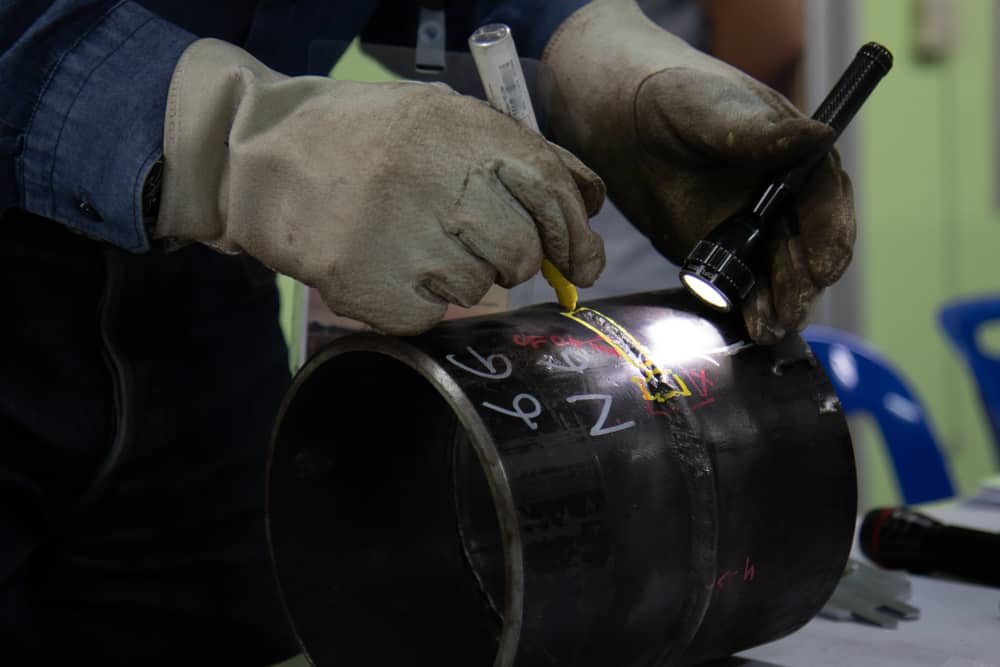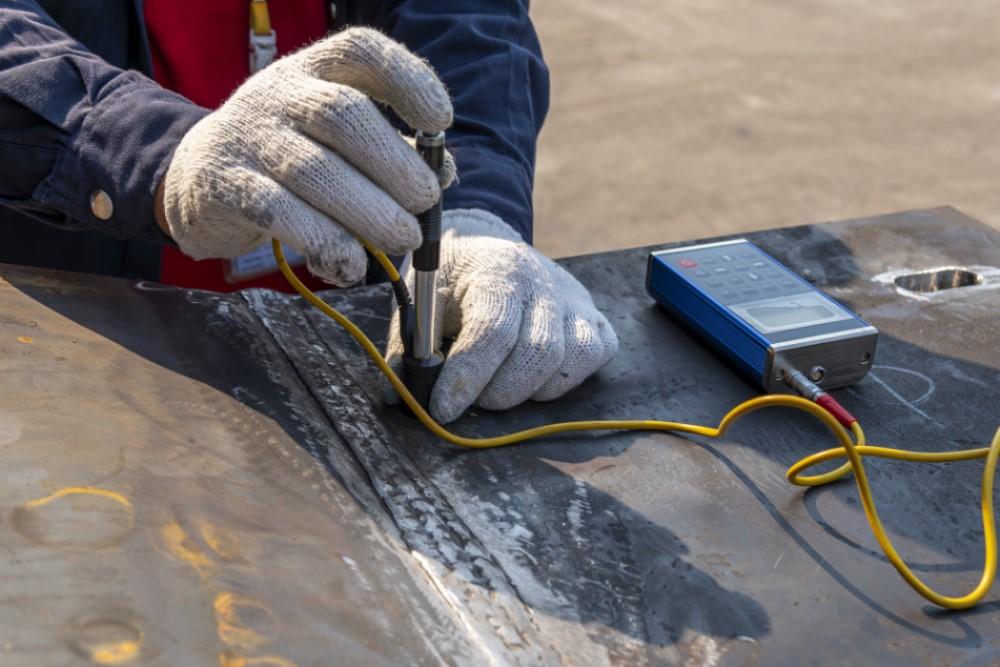Exactly How Welding Inspection Functions: An In-Depth Analysis of Approaches, Criteria, and the Function of Assessors in Ensuring Architectural Stability and Security
Welding examination is a crucial component in the building and construction and production markets, where the honesty of welded joints is paramount to security and dependability. Numerous approaches, including non-destructive and visual testing techniques, are used to discover prospective problems that could endanger architectural performance - Houston Welding Inspection. Assessors are entrusted with not just assessing weld quality against rigorous criteria however also analyzing intricate codes and requirements. As we explore the complexities of this career, the obstacles encountered by inspectors in preserving safety and security and compliance will expose a much deeper understanding of their important role in guarding infrastructure.
Significance of Welding Evaluation
Welding inspection is important in making certain the honesty and security of welded structures, with studies indicating that approximately 70% of structural failures can be mapped back to inadequate welding practices. This highlights the importance of methodical inspection procedures throughout the welding lifecycle, from prep work to conclusion. Effective inspection not only determines problems before they rise into considerable concerns yet additionally makes certain conformity with market criteria and laws.

The duty of welding inspectors extends beyond plain quality assurance; they are crucial in guarding public safety and security and decreasing obligation for companies. By implementing extensive assessment protocols, business can identify troubles such as incomplete combination, cracks, or too much porosity, which can compromise the overall strength of a bonded joint. Continuous training and accreditation of inspectors add to the overall top quality guarantee in welding procedures, promoting a society of safety and excellence.
Additionally, welding examination plays a crucial role in maintaining operational performance. Determining issues early in the process assists in prompt rehabilitative activities, lowering expensive rework and job hold-ups. Inevitably, a durable examination framework functions as a structure for reliable and long lasting bonded frameworks, guaranteeing they meet both useful and safety and security requirements.
Typical Inspection Methods
Exactly how can one ensure the high quality of bonded joints throughout the examination procedure? The execution of various examination techniques is critical in assessing weld honesty and determining potential defects. Typical approaches consist of Visual Examination (VT), which is typically the first line of protection, enabling assessors to detect surface area problems such as splits, porosity, or insufficient blend by visually examining the welds.
Ultrasonic Testing (UT) is one more widely made use of strategy, utilizing high-frequency acoustic waves to recognize interior issues within the weld. This method is especially efficient for identifying concerns that are not visible to the nude eye. Radiographic Examining (RT) makes use of X-rays or gamma rays to create photos of the weld, allowing the recognition of volumetric defects, such as inclusions or spaces.
Magnetic Bit Examining (MT) and Fluid Penetrant Evaluating (PT) are likewise popular methods, concentrating on surface issues. MT relies upon electromagnetic fields to disclose surface and near-surface stoppages, while PT entails applying a fluid dye to highlight problems. Each of these techniques serves an unique objective, making sure the extensive analysis of bonded joints and guarding structural stability and security.
Standards for Assessing Welds
The assessment of welds is guided by a collection of well-known requirements that guarantee both capability and security in welded frameworks. These criteria encompass various variables, consisting of weld dimension, account, and penetration, which must adhere to defined criteria. Conformity with sector codes, such as those established by the American Welding Society (AWS) or the American Culture of Mechanical Engineers (ASME), is important in link establishing the reputation of a weld.

Weld metallurgy plays a critical role; the analysis considers the blend quality between base and filler products, along with heat-affected areas. Lastly, the overall mechanical residential properties, including tensile stamina and ductility, must meet the demands developed for the particular application. Collectively, these criteria make certain that welds not only fulfill aesthetic standards yet additionally execute dependably under functional problems.
Function of Welding Inspectors
A welding examiner's proficiency is crucial in guaranteeing the stability and high quality of bonded frameworks. These experts play a crucial function in the manufacture and building process by verifying that welding procedures comply with developed criteria and requirements. Their duties incorporate a thorough variety of jobs, including aesthetic examination of welds, reviewing welding documents, and carrying out non-destructive screening (NDT) techniques such as ultrasonic or radiographic testing to recognize defects.
Welding examiners are likewise in charge of translating welding codes and standards, making certain that the welders are qualified and that the materials used fulfill the needed needs - Houston Welding Inspection. They have to keep precise documents of examinations, which function as documents of compliance and quality control. These inspectors typically team up with designers and project managers to deal with any problems that develop during the welding procedure, offering referrals for restorative actions when required.
Along with technical skills, effective interaction is crucial, as welding inspectors should communicate searchings for clearly to stakeholders and help with training and support for welders. Inevitably, their role is essential to Discover More Here keeping safety and security and reliability in welded structures, adding substantially to the general success of construction jobs.

Difficulties in Welding Inspection
What challenges do welding assessors encounter in their critical function? The intricacies of modern welding methods and materials existing considerable difficulties for examiners entrusted with making certain conformity with safety standards and structural honesty.
Furthermore, assessors typically come across variations in worksite conditions that can hinder evaluation processes. Elements such as environmental conditions, ease of access, and the physical state of the bonded frameworks can complicate thorough evaluations. Time constraints enforced by task schedules can further pressure inspectors, potentially affecting the thoroughness of their evaluations.
In addition, the subjective nature of some examination approaches can lead to inconsistencies in examinations. For instance, visual examinations may differ based on the inspector's experience and viewpoint. To alleviate these difficulties, the fostering of innovative non-destructive screening strategies and standard protocols becomes important - Houston Welding Inspection. Ultimately, overcoming these barriers is important for making certain the safety and reliability of welded frameworks across various industries.
Final Thought
Welding examination is essential for maintaining structural integrity and safety and security in different sectors. Via the application of varied inspection methods and adherence to established requirements, assessors play an essential function in identifying problems and making certain conformity with sector criteria. The challenges encountered in this field highlight the necessity for continual improvement in examination strategies and practices. Eventually, efficient welding inspection contributes substantially to mitigating risks and enhancing the general reliability of welded frameworks.
Welding inspection is a vital element in the building and manufacturing markets, where the integrity of welded joints is paramount to safety and security and dependability.Welding evaluation is essential in ensuring the stability and safety of welded frameworks, with researches suggesting that up to 70% of structural failures can be next traced back to poor welding methods. Their responsibilities incorporate a comprehensive range of jobs, consisting of visual assessment of welds, examining welding documents, and conducting non-destructive testing (NDT) approaches such as radiographic or ultrasonic screening to identify flaws.
Welding examiners are likewise responsible for interpreting welding codes and requirements, guaranteeing that the welders are qualified and that the products made use of satisfy the necessary needs. Eventually, efficient welding evaluation contributes substantially to mitigating threats and improving the overall reliability of welded frameworks.